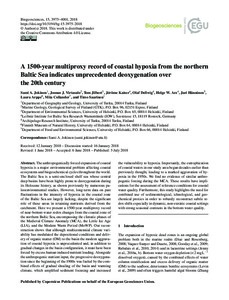A 1500-year multiproxy record of coastal hypoxia from the northern Baltic Sea indicates unprecedented deoxygenation over the 20th century
Sami A. Jokinen; Joonas J. Virtasalo; Tom Jilbert; Jérôme Kaiser; Olaf Dellwig; Helge W. Arz; Jari Hänninen; Laura Arppe; Miia Collander; Timo Saarinen
https://urn.fi/URN:NBN:fi-fe2021042719228
Tiivistelmä
The anthropogenically forced expansion of coastal hypoxia is a major
environmental problem affecting coastal ecosystems and biogeochemical
cycles throughout the world. The Baltic Sea is a semi-enclosed shelf sea
whose central deep basins have been highly prone to deoxygenation
during its Holocene history, as shown previously by numerous
paleoenvironmental studies. However, long-term data on past fluctuations
in the intensity of hypoxia in the coastal zone of the Baltic Sea are
largely lacking, despite the significant role of these areas in
retaining nutrients derived from the catchment. Here we present a
1500-year multiproxy record of near-bottom water redox changes from the
coastal zone of the northern Baltic Sea, encompassing the climatic
phases of the Medieval Climate Anomaly (MCA), the Little Ice Age (LIA),
and the Modern Warm Period (MoWP). Our reconstruction shows that
although multicentennial climate variability has modulated the
depositional conditions and delivery of organic matter (OM) to the basin
the modern aggravation of coastal hypoxia is unprecedented and, in
addition to gradual changes in the basin configuration, it must have
been forced by excess human-induced nutrient loading. Alongside the
anthropogenic nutrient input, the progressive deoxygenation since the
beginning of the 1900s was fueled by the combined effects of gradual
shoaling of the basin and warming climate, which amplified sediment
focusing and increased the vulnerability to hypoxia. Importantly, the
eutrophication of coastal waters in our study area began decades earlier
than previously thought, leading to a marked aggravation of hypoxia in
the 1950s. We find no evidence of similar anthropogenic forcing during
the MCA. These results have implications for the assessment of reference
conditions for coastal water quality. Furthermore, this study
highlights the need for combined use of sedimentological, ichnological,
and geochemical proxies in order to robustly reconstruct subtle redox
shifts especially in dynamic, non-euxinic coastal settings with strong
seasonal contrasts in the bottom water quality.
Kokoelmat
- Rinnakkaistallenteet [27094]
